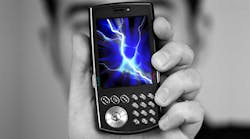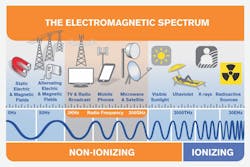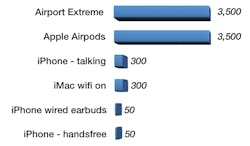Is Wireless Power as Safe as Other Consumer Technology?
What you’ll learn:
- Why safety in technology is relative to knowledge.
- Why far-field wireless power is as safe as technology we already use.
- How to become aware of the radiative areas around you.
- How close are we to developing a home wireless-power network?
In today’s digital world, we constantly rely on various power sources for consumer technology. Our mobile services, Bluetooth technologies, and internet connections all need power to function, whether it comes through solar, batteries, or what-have-you. More and more, we’re using battery-powered devices that we carry for hours on end.
For instance, you’re probably reading this with a battery-powered laptop or your ever-present smartphone. All of these devices and technologies give off low-level, non-ionizing (less potentially harmful than ionizing) radiation in the form of an electromagnetic field (EMF). But you’re likely not too concerned about it, because you trust that these devices are safe.
After all, these technologies are approved for use and cleared by the Federal Communications Commission (FCC). So, for the most part, you don’t hesitate to trust your health and safety to the experts when it comes to these tried-and-true devices.
On the other hand, you might be somewhat nervous when it comes to new technologies. For example, there are now ways to deliver power wirelessly through the air through a network of small wireless-power transmitters, called wireless-power-transfer (WPT) networks.
But while it might be nice to forego wires that tether you to the wall whenever you need to charge your device, it’s understandable you might be leery of the safety levels for this new technology. Fortunately for you, the safety of WPT has already been confirmed by the FCC, so it’s likely that you can lose the wires without compromising your health. Let’s look at what that confirmation means for you.
How Safe is Wireless Tech?
When you’re at your desk, at the gym, on a hike, or simply relaxing, how often do you use your wireless headphones or earbuds? You might even be using them now. You probably have a certain amount of confidence in your purchase of that technology. And you can usually trust that gear as widely used as earbuds or wireless headphones is safe to use.
The headphones and all of the technology that supports it are regulated, and the manufacturers need to build and sell products that meet those safety specifications. If they weren’t, we’d have likely heard about it in the news by now.
In truth, wireless earbuds produce 10X the EMF of what you’d experience from your mobile phone’s speakers. And while that’s about the same EMF as your Wi-Fi router emits, your router sits in a designated area of your house or office. Your earbuds stay with you for long periods of time. Are they safe?
The short answer is “likely yes.” If the FCC approves the level of EMF transmissions, the earbuds and VR tech are considered safe.
But what about walking into electronics stores? A trip to the Apple Store, Best Buy, or Walmart probably doesn’t promote a sense of impending EMF doom for you. Even with all of those televisions lining the walls, the cellphones, the computer screens blaring energy, not to mention various other electrically powered devices emitting EMF, you still feel safe. And you should.
Yes, there’s a ton of energy being blasted at you—all the time—but you don’t feel the need to run for cover because you know the devices are generally considered safe.
The same goes for your home. If you look around, you’ll likely see any number of EMF sources like electrical devices, light bulbs, appliances, TVs, and Wi-Fi, all of which are, according to the FCC, generally considered to be safe.
What does “safe” mean to the FCC? The EMF radiated by these devices is in the form of RF energy. RF is low-level, non-ionizing radiation, which means it doesn’t damage DNA or cause cancer, as shown in numerous studies. Yet, if the RF is strong enough, it can overheat parts of your body and cause serious burns. Thus, a safe level of EMF means the RF isn’t strong enough to overheat and destroy your cells.
The FCC measures how much RF your body absorbs in terms of a specific absorption rate (SAR). And according to the FCC, the SAR for mobile devices in a worst-case scenario—meaning the device is outputting RF is at its highest power and/or closest to your body—needs to be no more than 1.6 W per kilogram of human tissue.
A WPT network creates an environment with EMF levels like those of the devices in your home, your workplace, or your typical electronics retailer. The WPT is working in the background, recharging any of your devices within range of the transmitters.
The future vision of WPT allows for a whole network of environments that can safely and smartly manage EMF levels within the bounds of what we already experience while providing wireless power through the air every day. In other words, you’ll no longer need charging cords cluttering your home or office.
But the future of WPT goes beyond your home or personal office. Power transmitters in streetlamps or even satellites could recharge a passing drone, the handheld device in your pocket, or even your smart car while you’re driving to work. There’s no end to the potential applications of this technology.
Wireless Power Safety
Because they know the risks of high-level EMF, wireless power providers know that they must adhere to FCC rules and other safety regulations. So, just as you know that you can safely have a battery housed inside your ear, or a phalanx of TVs and other EMF-radiating devices surrounding you at the electronics store, you can know that WPT networks are held to the same standards.
In 2021, experts arranged a study to test the safety and effectiveness of WPT. Representatives from WiGL, along with the Department of Electrical and Computer Engineering at Florida International University, demonstrated the safety levels of WPT with small, scalable applications, such as charging a single smartphone within an 8- × 10-ft. area using power transmitters. The goal was to adhere to the RF limits in accordance with FDA and FCC guidelines while providing power to the device within that area.
We were able to charge the device wirelessly through the transmitters while measuring the levels of radiation in the zones nearest to the transmitters (the near zone) and further away (the far zone). Transmitters at a power level of 1 W were able to deliver a significant charge to the smartphone within that area, and the RF levels were well within the FCC-allowed margin.
We foresee two potential benefits of the WPT technology soon. Firstly, powering devices wirelessly even while they’re moving and in use means device users will no longer have to be tethered to a wall while their phone charges. Secondly, mobile device and wearable technology manufacturing costs could go down considerably because devices will require smaller batteries or even no battery at all.
WPT’s Bottom Line
As technology leaders explore this new horizon of WPT technology, it’s understandable and important for people to be concerned about safety. And we should never become complacent about the safety of EMF.
But it’s also important to know that strict rules and regulations are in place to protect consumers, just as there are for any other consumer technology, and that WPT doesn’t have to affect us any more than the devices already surrounding us. The world seems to be ready for full-scale wireless charging.


